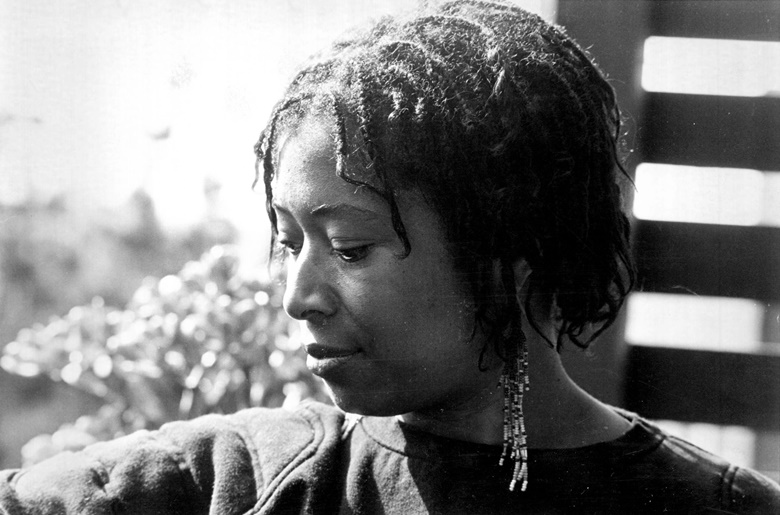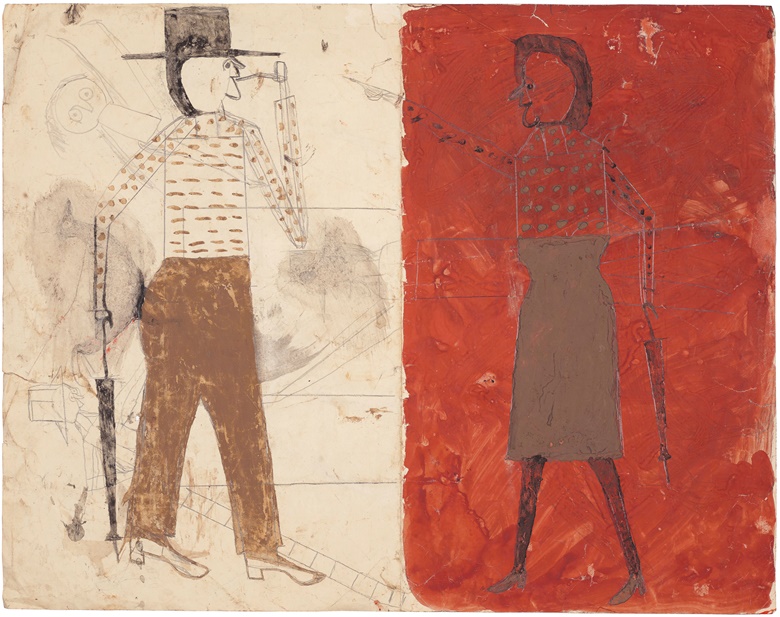The Pulitzer Prize-winning author, the legendary film director and the outsider artist
Novelist Alice Walker, author of The Color Purple, on the Bill Traylor work gifted to her by Steven Spielberg — coming to Christie’s on 17 January
When Steven Spielberg completed the film adaptation of the novel The Color Purple in 1985 he gifted its author, Alice Walker, a painting titled Man on White, Woman on Red by the African-American artist Bill Traylor. ‘He was hopeful (he said with a smile) that when I saw the film, I wouldn’t feel like the angry Woman on Red,’ says Walker. ‘I answered (with a laugh), “I hope so too.”’
Walker’s harrowing but redemptive novel had been published three years earlier in 1982. It recounted the story of Celie, a poor black girl surviving in rural Georgia between the two world wars. It was, and still is, a landmark work. Disturbing and exhilarating, it transformed African-American literature and won the author a Pulitzer Prize for fiction.

In the film adaptation, Celie was played memorably by Whoopi Goldberg, while Danny Glover brought a bruised vulnerability to the abusive Mister. Oprah Winfrey acted the part of the feisty Sofia.
The writer had reservations about allowing the action movie director to adapt her book — one that relied so heavily on Celie’s introspection — but the set, she said in an interview for BBC Radio 4, was ‘blessed by angels, it was so full of love that it was palpable, every single person wanted to do his or her best’.
When Walker eventually saw the film at a private viewing in San Francisco, she admits that she had reservations. ‘But,’ she added, ‘I soon came to realise that Steven’s The Color Purple is a masterpiece.’ The movie was released in 1986 and went on to become a box-office success, staying in US theatres for 21 weeks and grossing more than $142 million worldwide.

Cara Zimmerman, a Christie’s specialist in Outsider Art, explains that the painting Spielberg gave Walker was significant. ‘There is an interesting conversation between The Color Purple and Traylor’s art because both consider a similar moment in American history — hers looking back, his from a contemporaneous perspective,’ she says.
Like the characters in The Color Purple, Bill Traylor (circa 1853-1949) lived and worked in the South in the first half of the 1900s. He was born into slavery in 1853 and was nine years old when emancipation came following the Civil War. Like many ex-slaves trapped by economic privation, he became a sharecropper, working long, brutal hours in the fields.
Walker knew artists like Traylor in her childhood. ‘I like folk art. And admire folk artists like Bill Traylor,’ she says. ‘Growing up in Georgia, I knew such an artist. With no education and no art instruction, Jimmy Lee Brundage created moving depictions of blacks and whites. And trees and animals. He was my introduction to the power of art to reach everyone.
‘When Steven Spielberg gave me this painting I thought of Jimmy Lee. His art hung in a local country store. He was gifted but never seemed to think much about it. We loved him for this
‘I was glad that Bill Traylor’s work was being seen and affirmed. That it had spoken to Steven [Spielberg]’ — Alice Walker
Brundage and Traylor are part of a canon of African-American artists whose creative spirit endured, despite poverty, racism and a lack of educational opportunities. It is one of the themes that runs through The Color Purple, as Walker explains.
‘I was glad that Bill Traylor’s work was being seen and affirmed,’ she says. ‘That it had spoken to Steven and he had seen, and felt, the connection between this black male artist and Celie and Shug, both black women country artists in The Color Purple at a time they were not (especially Celie) affirmed as such.’
This affirmation has translated into some important exhibitions for Traylor in recent years. He has been the subject of a major retrospective at the Smithsonian American Art Museum, Washington D.C., and his work hangs in, among other places, the Metropolitan Museum of Art, the Museum of Modern Art, New York and the Philadelphia Museum of Art.The reverse side of the painting featuring the picture Man with Black Dog (double-sided), 1939-1942. Tempera and graphite on repurposed paper. 18⅞ x 24 in (48 x 61 cm). Estimate: $200,000-400,000. Property from the Collection of Alice Walker, offered in the Outsider Art sale at Christie’s New York on 17 January 2020
Zimmerman describes Traylor as ‘an artist’s artist’, explaining that he has found a new audience in young painters. ‘His work can often bridge collecting categories,’ she explains, ‘serving as a link between regions, time periods, and genres through his personal history, his incorporation of American pop culture, and his distinct aesthetic that resonates visually with a range of artistic outputs, from cave paintings to Modernism.’
When Zimmerman removed Man on White, Woman on Red, from its frame, she discovered another painting of a man and a dog on the reverse. ‘The work is unique in this respect,’ she says, ‘and presents us with another intriguing story.’ The painting is now titled Man on White, Woman on Red/Man with Black Dog (double-sided).











